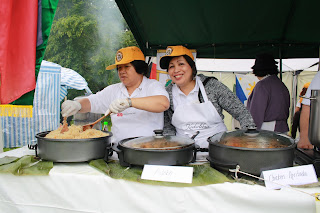 |
| Rizal's ancestral home in Calamba (aka Rizal Shrine) |
Jose Rizal's father, Francisco Mercado, and mother, Teodora Alonso, originally came from the town of Biñan in Laguna but decided to settle in Calamba after their 1848 wedding. They built the first hardwood and stone house in Calamba, which is now known as the Rizal shrine. The house lies very near to the biggest catholic church in Calamba at that time - a sign of the family's affluence.
After Rizal's family was driven out of the house by the Spaniards, the house was sold to Don Isidro, the governor's brother, who in turn, started renting it out. The Philippine government purchased the house but World War II caused significant damage to the original structure. What is standing now is actually a reconstruction of the house rendered by National Artist for Architecture Juan Nakpil based on photographs of houses in that era and from inputs of family members. President Elpidio Quirino re-opened the house for public viewing after re-construction finished in 1950.
 |
| The entrance in the lower part of the house with the grand stairs |
The lower part of the house which is made of stone is where Rizal's mother, Teodora Alonso ran a general merchandise store. The main entrance is a big heavy door which opens into a grand staircase leading to a second floor landing (caida) which used to be the family's library.
 |
| The landing (caida) on the second floor |
 |
| The dining room |
The garden at the back of the house contains a small nipa hut where the young Rizal spent many hours with his brother and sisters playing and discovering. The Philippine Department of Interior and Local Government (DILG) decided to transfer the remains of Rizal's parents back to Calamba and bury them on the left side of the grounds behind the house.
 |
| The remains of Jose Rizal's parents were transferred by Sen. Lina to the garden |
Recently, the National Historical Commission of the Philippines added an exhibit of artifacts used by Rizal in the later stages of his life. The exhibit includes coats and vests worn by our national hero, some sculptures and a fragment of the coat Rizal worn during his execution in 1896.
 |
| Rizal's statue in the garden of the house |
The Rizal Shrine is open from Tuesdays to Sundays 8:00-12:00 noon and from 1:00-5:00pm. Admission is free! Let us take the wonderful opportunity to get to know our national hero better and fully appreciate the sacrifices he made for the sake of our freedom.
(All photographs courtesy of Sir Dirk Hampel)










